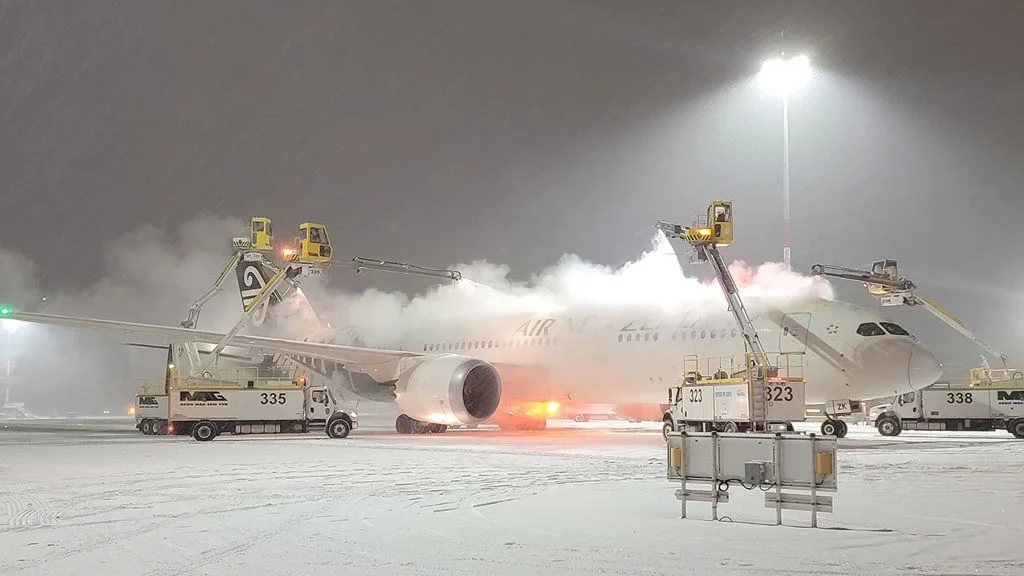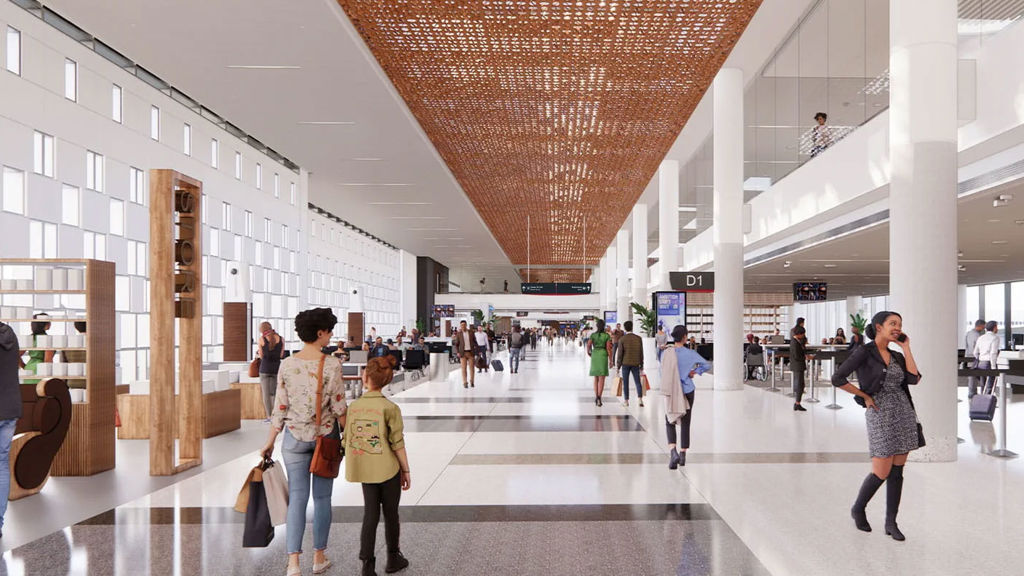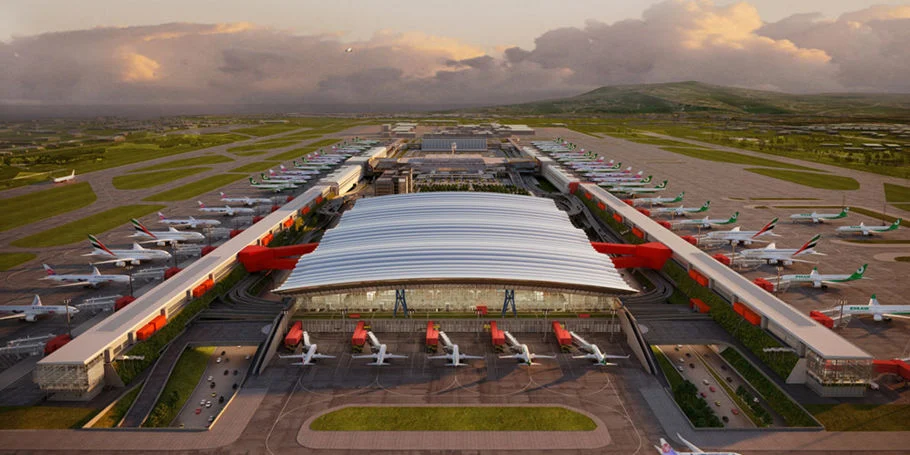Transforming the travel experience at Zayed International Airport
Zayed International Airport Terminal A

What we delivered
-
The building’s design has helped reduce the typical flight connection time for passengers by 45 minutes
Get in touch with our team
As Abu Dhabi gains more visitor popularity, Zayed International Airport has quickly become the Middle East’s fastest growing airport by seat capacity. Its annual passenger capacity reaching up to 45 million passengers, and currently hosts flight routes spanning to over 126 destinations worldwide. Arup helped design the airport's new Terminal A, ready to handle the increasing demands of modern air travel in this dynamic region.
Collaborating with Abu Dhabi Airports and Kohn Pederson Fox Architects (KPF), our team provided a host of multi-disciplinary services for the new terminal building, including structural engineering, façade design, lighting design, building services design, and bridge and tunnel engineering. We also worked closely with all the key stakeholders to complete comprehensive modelling of the terminal’s passenger flow, enabling it to achieve a world class passenger experience by optimising e-gate and baggage checking infrastructure.
The X-shaped terminal building, which stretches across four main piers over a cross length of around 1.5km, serves as a new Middle East aviation hub that supports a wide network of international airlines, and is home to the UAE’s flag carrier, Etihad Airways. Designed to accommodate a growing influx of international travellers, the new terminal strengthens Abu Dhabi's position as a leading centre for tourism, trade, and commerce.
Structural design
At the heart of Terminal A lies the magnificent main concourse, a cavernous space where every passenger journeys beneath a breathtaking canopy of eighteen leaning arches. These architectural marvels, reaching spans of up to 180m, are engineered as triangular steel lattice trusses, poised in pairs yet never touching. Sculptural buttresses spring from the concourse floor, supporting the arches' tapered ends, while backstays lace between buttress and roof, ensuring stability. Above, the undulating roof, a symphony of curves in every direction, sails gracefully. Wave-profiled steel girders, supported by slender struts, rest indirectly on the arches. This innovative design, optimising the depth of each girder, minimises material use while creating a stunning visual spectacle. Light steel beams and lattice trusses span up to 44m between the roof girders, and long steel cantilevers extend over the façade walls, offering welcome shade.
The structural slabs at the departures level of the building were also designed to provide a wide 300x300m concourse, enabling passengers to pass through the terminal quickly and easily.
Our team worked to reduce the terminal's embodied carbon throughout all elements of its structural design. Terminal A was awarded ‘Green Building Certified’ by the UAE’s Pearl Building Ratings System, achieving 3 Pearls during design stage.
Façade and roof design
The façade of the Midfield Terminal at Zayed International Airport is a masterful blend of transparency and modernity. Composed primarily of a glass curtain wall system, the façade allows natural light to permeate the interior while utilising advanced glazing coating and fritting techniques to minimize glare and heat. Metallic elements, aluminium and steel, complement the glass, adding a sleek and sophisticated aesthetic. Exposed structural components, such as visible steel supports and bracing, enhance the architectural interest and underscore the engineering marvel of the building. Notably, some of these steel elements also support the roof, a unique function for façade systems. Additionally, the façades are designed and tested to withstand seismic events, with the main façade engineered to resist blast explosions, ensuring safety and resilience.

The main concourse sits beneath a breathtaking canopy of leaning arches reaching spans of up to 180m

The new Middle East aviation hub supports a wide network of international airlines
Lighting design
Designed with the passenger experience at the forefront of this project, utilising energy-efficient LED lighting and advanced environmental systems to create a welcoming experience for all guests. With a combination of natural daylight and carefully planned architectural lighting solutions, the new terminal provides visual comfort and ambience, as well as meeting environmental standards for travellers and airport personnel.
Building services design
Terminal A uses a vast flow of outdoor air, which needs to be cooled during scorching temperatures exceeding 47°C. Therefore, to reduce energy consumption, outside air provision to Terminal A is precisely regulated. Air quality monitoring is directly linked to the ventilation system dynamically adjusting to the constantly changing environment inside and outside the building. This also takes account of air pollution build up, seasonal influences, time of day, temperature, humidity, the number of people in the terminal, and the architectural environment.
The scale and complexity of the Terminal building meant that conventional approaches to fire protection and fire-fighting systems could not cope with the vast volume of the space, for which Arup’s engineers developed a bespoke fire protection code specifically for the airport. This innovative approach optimised the scale and effectiveness of the systems for the new terminal, while fully complying with all Civil Defence regulations. This innovative approach not only saved valuable time and resources, but also resulted in a more efficient and cost-effective facility with reduced operational and maintenance expenses.
Bridge design
The vision for Terminal A involved the design of a number of long-span concrete structures, each of up to 600m in length. These complex bridge structures with spans of up to 36m form an integral part of the departures level floorplate providing an interface between the internal and external environments. Designed to appear as a continuous part of the building, providing connection from the Terminal through to a viaduct for departures-bound traffic outside of the façade. Two elevated footbridge structures with complex façades link the car park building to Terminal A, passing above the arrival's concourse and below the departure's concourse.

The façade, made primarily of a glass curtain wall system, allows natural light to flood the interior

A number of complex bridge structures provide an interface between internal and external environments
All images © Victor Romero, Joey Lawrence and Abu Dhabi Airports
Projects
Explore more aviation projects:

Redefining Japan’s future airport city
Narita Airport City, Japan

Crafting a New York–inspired atmosphere for passengers traveling through JFK’s global gateway to the world
JFK New Terminal One Art, Branding, and Digital Experience Program, United States of America

Helping Vancouver International Airport to prepare for unexpected weather
Vancouver International Airport After Action Review, Canada

Seamless redevelopment and renovation at George Bush Intercontinental Airport
IAH Terminal Redevelopment Program, United States of America
Get in touch with us
If you'd like to speak to one of our aviation experts about any of the issues raised on this page or a potential collaboration then please get in touch by completing the form.

